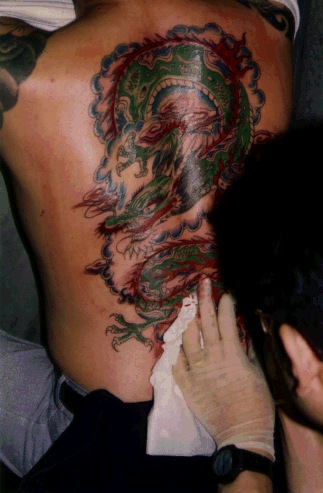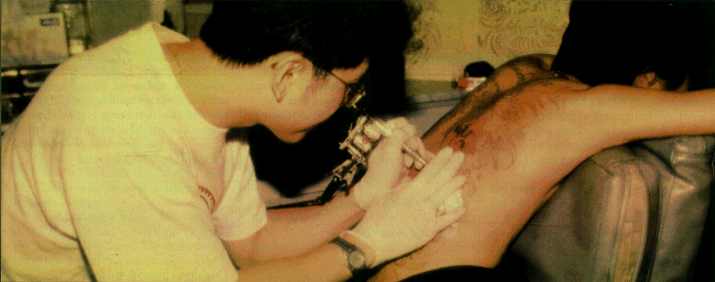 Skin-deep beauty
Skin-deep beautyTattoos are a combination of traditional art, modern science
By Shirley Lau
I nside his studio, Mr. Hui Chi Fai draws lively figures, such as dragons, phoenixes and heroic figures from the past. Being a tattooist rather than an artist, however, his art works are created on human skin. The tattooing process requires needle injections of permanent dyes beneath the uppermost layers of the skin.
According to Mr. Hui, China has the earliest history of tattooing in the books. In the old days, tattooing was a popular artistic form of body decoration.
Mr. Hui, who started learning tattooing from a relative at age 15, has his own studio, called Chynese Tattoo, in Tsim Sha Tsui.
He said, “In Hong Kong, there are totally five tattoo studios, and the other four are located in tourist areas like Jordan and Wan Chai.”
Mr. Hui has been working in the field for more than 20 years. When his tattoo business started, his customers were mainly foreigners.
Said he: “That was the time when the Vietnam War was going on. American soldiers who passed though Hong Kong liked to have their bodies tattooed. However, nowadays the number of local customers is half that of foreigners.”
Mr. Hui said his local customers include truck drivers, hairdressers, heavy metal bandsmen and white-collar workers. Sometimes, lovers come into his shop in pairs to tattoo their partners’ names on their bodies.
“I’m not sure about the backgrounds of my customers. I think some of them may be triad members, but most of them are not so rude and perverted as society might think,” said he.
According to Mr. Hui, dragons are the most popular patterns for local tattooed people, while foreigners favour Hebrew and ancient Egyptian patterns. Compared with men, tattooed women tend to choose smaller designs.
Any part of the skin can be tattooed. It can be one’s chest, hips, private parts or even lips. But Mr. Hui said only foreigners have tattoos on their private parts.
Mr. Hui said the price of a tattoo depends on the pattern’s size. Tattoos the size of a $5 coin cost about $150, while tattooing one’s back fully with different colours costs more than $7,000.
To many tattooed people, a tattoo may mean much more than a colourful pattern. It can also be a reflection of their desires.
Said Mr. William Marshall, 26, a tourist from South Africa: “My father works in the army and has got 19 tattoos. I inherited the idea of getting tattoos from him.
“Also, tattooing is a way to express my desire for something. While the eagle tattooed on my arm represents freedom, the tiger on my chest is a sign of strength.”
Another reason behind Mr. Marshall’s tattoos is the high popularity of tattoos among young adults in his mother country. Most of his friends have much more tattoos than he does, said he.
This time, he asked Mr. Hui to tattoo the symbol of an Indian warrior on his left arm. He said he decided to have a total of 13 tattoos.
“Thirteen is conceived to be an unlucky number, but I don’t like conforming to the conventional beliefs of society,” said he.
Not all tattooed people enjoy the marks for life.
Mr. Kenny Tong, 24, of Kwun Tong today regrets having his arm tattooed with a dragon. He recalled the reason for making such a decision: “Most of my friends have one or two tattoos. Influenced by peer pressure and eager for a sense of recognition, I had it done. I thought a tattoo would make me look smarter.
“I really regret that because the price of tattooing is high. I once applied for the position as an office assistant. Though I was qualified for the job, I was turned down. I guess that was because of the tattooon on my left arm, as I wore a short-sleeved shirt that day.
“Now I wear a long-sleeved shirt even on a hot day to cover the dragon,” said Mr. Tong, who is now a waiter in a karaoke lounge.

The whole process lasts from 45 minutes to three hours, depending on the size of the tattoo. Finally, the punctured skin is bandaged. For a few days, there is a scab on the skin. However, within a few weeks, the skin heals completely and the tattoo decorates the body.
Both Mr. Marshall and Mr. Tong agreed that pricking a tattoo feels like being injected or stung by rose thorns. The difference is that after a tattoo, the feeling lasts longer.
Mr. Hiu said, “The tattooing process may not cause much pain. Indeed, tattooed people may be made numb. Besides, everyone has a different level of tolerance for pain. Generally, women are more tolerant than men because they have more subcutaneous fat.”
He added that bleeding is inevitable, but an experienced tattooist minimizes the amount of blood by not penetrating needles into the skin too deeply. He added that only one out of 200 of his clients has side-effects on their tattooed skin. These include an itchy feeling and inflammation.
Apart from having short-term pain, tattooing may bring lifelong suffering if hygiene is unobserved by tattooists.
According to Dr. Francis Ho of St. Teresa Hospital, tattoo needles which are not disposable or not sterilized properly can cause infection with HIV, which is the AIDS virus, or hepatitis. Therefore, the safety of tattooing depends much on the professional ethics of tattooists.
Said Mr. Hui: “Indeed, tattooists nowadays are much more careful than they were 10 years ago. Apart from using disposable needles, the tattooed areas are cleaned and disinfected beforehand. In short, the tattooing process is very hygenic on the whole.”
Even so, many still resist tattooing because of tattoo’s permanence.
Mr. Hui said since the density of the pigments deposited beneath human skin surface is fairly high, the water within our skin cells is unable to decompose them. The pigments therefore remain dry and stay permanently under the tattooee’s skin.
Nevertheless, there is a way of getting rid of tattoos.
Dr. Ho said that in the past, removal of tattoos often left unpleasant and permanent scars. The process caused injury to skin, as the tattooed skin was removed altogether with the pigments underneath.
Recently, a high-tech process — a laser tattoo-removal technique — has been successfully developed to remove tattoos without injury.
Explained Dr. Ho: “By this technology, lasers deliver short bursts of energy into the tattooed body parts and the tattoo pigments are broken up. Patients just feel like they are being snapped by a rubber band. “After multiple treatments on about five to eight occasions, the tattoo pigments will be thoroughly eliminated from the body, without leaving any scar.”
Dr. Ho added that each treatment takes about 15 minutes and costs thousands of dollars, depending on the size of the tattoo.
According to Dr. Ho, the number of people who come to remove their tattoos is rising. Most of them are out of regret, as tattooing is generally not accepted by society.
He also advised people to give it careful thought before getting tattoos. Even though the tattoo can be removed, one may have emotional suffering and pay the high price of the surgery.
Today, people’s passions for tattooing seems to have cooled compared to the last decade.
Said Mr. Hui: “People are gradually aware of the adverse effects of having tattoos.
Moreover, tattooing is a trend, just like fashion. When this trend is over, another trend — hair-dyeing, say — comes along,” added he.
Nonetheless, he does not worry about the future of his tattoo business.
“I believe that all small businesses can find a toehold somewhere to survive. Although tattooing has become less popular here, my income hasn’t fallen much. A stable number of tourists keeps my business afloat.
“Besides, unlike Asia, tattoos lately have become a trend in Europe. If my business cannot survive here, I can start it again in Europe,
as long as I have tattooing skills,” said Mr. Hui.



